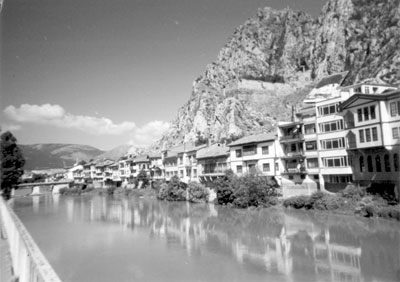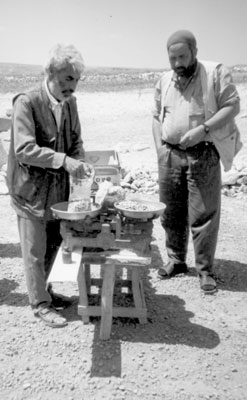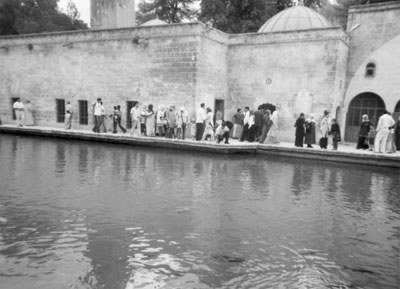Turkish delight
(Third of three parts, jump to part 1, part 2, part 3)
In this issue, I am continuing last month’s travelogue of the eastern Anatolia region of Turkey.
A visit to the Greek-Orthodox Sumela monastery should be on everyone’s itinerary. To reach it, take the highway leading from Trab-zon toward Erzurum and turn left at Macka. Continue on this road until you reach the Sumela restaurant, from where you get the best view of the building.
To me, the monastery looked like an apparition, the way it adhered to the cliff soaring high above the forest. Nobody knew how the workers got all the stones up there. It reminded me of the Buddhist monasteries we visited in Nepal.
To get to the structure, you either can climb a steep trail starting at the restaurant or you can drive on until the end of the road, where you find a small parking area. From there, a half-hour trail alternately climbs and falls toward the monastery through numerous staircases.
Since it is being restored, you can see only part of the frescoes that adorn the walls of the main chapel, which is cut into the rock.
Along the Black Sea coast
After visiting Sumela, Flory and I drove west along the Black Sea toward Amasya.
Road construction, accompanied by lots of dust, has been in progress along this stretch of the Black Sea for years. It slowly is transforming the present, very crowded 2-lane highway into a 4-lane freeway, always with an accompanying sea promenade inside the towns, reminding me of the boulevard des Anglais in Nice.
However, while some of the coastal areas were attractive, they cannot compare to the stunning beauty of the French Riviera. Most apartment buildings and houses along the coast are viciously drab, without any flowers to spruce up their appearance. Curiously, we did not see any boats on the Black Sea and noticed only an occasional cove and beach. Only in one area were a few children swimming.
Additional notes
Following the above travelogue on Turkey, I would like to close with the following pointers.
• Upon arrival at an airport or overland border, before going through passport control you must proceed to a separate counter to pay for your entry visa (if required) with cash, either in euros or U.S. dollars. (Check the amount before leaving home, as you need the correct change). After having made your contribution to the Turkish government, you must wait in another long line for Immigration, where a stamp on top of the visa makes your entry legal and the Immigration officer’s job secure.
• After escaping from officialdom, you may want to tackle the ATM (bankamatik). . .
While the requested cash presents itself quickly and efficiently, your ATM card frequently will remain inside the machine, making you wonder how you ever will get it back. Don’t fret. There is help for those in the know (for me, it was the person in line behind me). After your transaction, deftly press the red button marked “iptal” (cancel) and your card will eject immediately, causing your blood pressure to drop by 20 points.
• It seems straightforward to pilot a car in eastern Anatolia, as long as you drive defensively.
On the back of minibuses, you often find the words “Allah Korusun” (“May God Protect Me”), which seems to ask for forgiveness of unhealthy driving habits.
When crossing the street as a pedestrian, you take your life in your hands. Since cars won’t stop for you, you just have to get out of harm’s way.
During our visit, the price for unleaded gasoline was $7.50 a gallon! That was when we paid about $2.15 in the U.S.
Many roads boast an extraordinary number of huge gas stations, which commonly have public toilet facilities. In eastern Anatolia, these usually were the squat type.
The best places to use the WC are gas stations, restaurants and mosques.
• Keep in mind that front-desk hotel personnel, especially in eastern Anatolia, frequently don’t speak English. It is a good idea to have all your questions written out in Turkish beforehand and to inspect your lodgings before you accept. Make sure the room has adequate lighting, and check for any streetlamps or floodlights that might illuminate your sleeping area.
• It is customary to sample food and fruit from a roadside stand or from comestibles displayed outside a store even if you are only passing by and do not intend to buy anything.
• Be sure to see the whirling dervishes, who perform a ritual dance symbolizing their union with God. During the ceremony, they are dressed in long white robes, covered by black capes, with typical conical hats complementing their attire.
Accompanied by the haunting music of a reed flute, the dervishes spread their arms, hold their heads aslant and with a rapturous expression on their faces revolve on their left heels while whirling faster and faster.
The dervishes perform in Istanbul and Cappadocia. In addition, in December there is an annual festival in Konya, a city straight south of Ankara.
• I would like to recommend, in Ürgüp, the excellent restaurant La Padella (Dumlupinar Caddesi No. 33; phone 0384 341 68, Ürgüp). It has an interesting menu, quite different from the usual Turkish one. Including spirits, our delicious dinner cost YTL30 (new Turkish lira), or $22, for two. After completing our meal, when we asked the proprietor to call for a taxi to return us to our hotel, he insisted on driving us there himself.
• According to several locals we met, thievery is unknown in eastern Anatolia. Indeed, in several cities we parked our fully packed van in the street without having an attendant present. In the hotel in Dogubayazit, our guide’s luggage was left undisturbed in the corridor all day.
Unfortunately, the situation is quite the opposite in western Turkey.
While during the 1980s and ’90s guerrilla activity made traveling hazardous in southeastern Turkey, it is at the present time fairly safe, as most of the strife between the Kurdistan Workers Party (PKK) and the Turkish Army has ended. While we heard of an occasional skirmish during our trip, tour groups abounded.
• Turkish Airlines tickets are cheaper when bought inside Turkey (even through a travel agent) than in the U.S.
• Younger women often wear gorgeous, color-coordinated head scarves, blouses and long skirts.
• To pinpoint your stay in eastern Anatolia, carefully study the Climate and Planning chapters in Lonely Planet’s “Turkey” guide. Note that while the northern parts of eastern Anatolia may have snow until mid-May, the southeast may be stifling hot in June. In 2005, during our 3-week trip, which started on May 25, we encountered neither snow nor unusually hot weather.
Arranging our private tour
Argeus Tourism (Istiklal Cad. No. 7, 50400 Ürgüp, Turkey; phone 011/90 [384] 341 468 or fax 011/90 [384] 341 4888, e-mail inform@argeus.com.tr or visit www.argeus.com.tr) reserved all of our hotels, most of which I looked up on the Internet before we left. Most were 3- or 4-star modern properties.
Hotels, domestic airfare and most meals on our 21-day private tour of Cappadocia and eastern Anatolia were arranged by Argeus Tourism at a total cost to us of $8,360 for two.
Enjoy Turkey.
—The Discerning Traveler is written by Philip Wagenaar.



